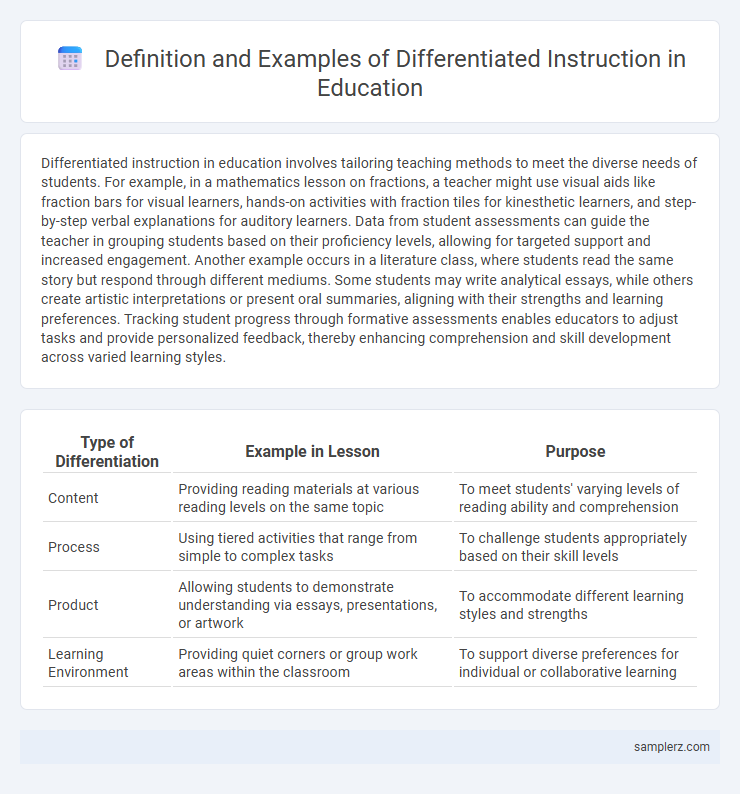Differentiated instruction in education involves tailoring teaching methods to meet the diverse needs of students. For example, in a mathematics lesson on fractions, a teacher might use visual aids like fraction bars for visual learners, hands-on activities with fraction tiles for kinesthetic learners, and step-by-step verbal explanations for auditory learners. Data from student assessments can guide the teacher in grouping students based on their proficiency levels, allowing for targeted support and increased engagement. Another example occurs in a literature class, where students read the same story but respond through different mediums. Some students may write analytical essays, while others create artistic interpretations or present oral summaries, aligning with their strengths and learning preferences. Tracking student progress through formative assessments enables educators to adjust tasks and provide personalized feedback, thereby enhancing comprehension and skill development across varied learning styles.
Table of Comparison
| Type of Differentiation | Example in Lesson | Purpose |
|---|---|---|
| Content | Providing reading materials at various reading levels on the same topic | To meet students' varying levels of reading ability and comprehension |
| Process | Using tiered activities that range from simple to complex tasks | To challenge students appropriately based on their skill levels |
| Product | Allowing students to demonstrate understanding via essays, presentations, or artwork | To accommodate different learning styles and strengths |
| Learning Environment | Providing quiet corners or group work areas within the classroom | To support diverse preferences for individual or collaborative learning |
Understanding Differentiated Instruction in Education
Differentiated instruction in education includes tailoring lessons to diverse student needs by varying content, process, and product based on individual learning styles and readiness levels. For example, a math teacher may provide visual aids for spatial learners, hands-on activities for kinesthetic students, and advanced problem sets for gifted learners within the same lesson plan. Implementing these strategies enhances student engagement and optimizes learning outcomes by addressing unique strengths and challenges.
Benefits of Differentiated Instruction for Diverse Learners
Differentiated instruction allows teachers to tailor lessons to accommodate diverse learning styles, readiness levels, and interests, which increases student engagement and motivation. Strategies such as flexible grouping, varied question prompts, and customized assignments help address individual needs, promoting deeper understanding and retention. This approach supports inclusive classrooms where all learners, including those with disabilities or English language challenges, can achieve academic success.
Tiered Assignments: Addressing Varied Skill Levels
Tiered assignments organize tasks at varying levels of difficulty to meet students' diverse skill sets within a lesson, ensuring personalized learning experiences. For example, in a mathematics class, students might solve basic equation problems, apply equations to real-world scenarios, or explore advanced applications, depending on their proficiency. This strategy supports skill development by challenging students appropriately and promoting growth across different learning levels.
Flexible Grouping Strategies in the Classroom
Flexible grouping strategies in the classroom involve organizing students into diverse groups that change based on learning objectives, skills, or interests, promoting personalized instruction. Examples include ability-based groups for targeted skill building, interest groups to boost engagement, and mixed-ability groups fostering peer learning and collaboration. This approach enhances student motivation, supports varied learning styles, and improves overall academic outcomes by adapting to individual needs in real-time.
Choice Boards for Student Autonomy and Engagement
Choice boards in differentiated instruction empower student autonomy by offering various activity options tailored to diverse learning styles and readiness levels, enhancing engagement and motivation. These boards cater to visual, auditory, and kinesthetic learners through tasks such as videos, podcasts, and hands-on projects, allowing students to select the method that best suits their preferences and strengths. Implementing choice boards fosters personalized learning experiences, promotes self-directed learning, and supports mastery of curriculum standards across varied student profiles.
Adjusting Content Based on Student Readiness
Differentiated instruction adjusts content complexity to match student readiness by providing varied reading materials, such as simplified texts for struggling readers and advanced articles for proficient readers. Teachers use pre-assessment data to group students and tailor lessons that scaffold learning objectives appropriately. This strategy enhances engagement and comprehension by meeting individual learning needs within the same lesson framework.
Differentiating Process Through Varied Activities
In a math lesson on fractions, teachers implement differentiated instruction by offering varied activities such as hands-on manipulatives for tactile learners, visual fraction models for visual learners, and interactive digital games for kinesthetic learners. Small group discussions allow students to process concepts at different paces based on their understanding, reinforcing personalized learning pathways. This approach maximizes engagement and comprehension by tailoring the learning process to diverse student needs.
Product-Based Assessment Options for Learners
Product-based assessment options in differentiated instruction include projects, presentations, and portfolios that allow learners to demonstrate understanding through creative outputs. These methods cater to diverse learning styles by offering choices such as designing models, composing written reports, or creating multimedia presentations. Teachers can tailor tasks to challenge students at varying skill levels while assessing mastery of core content effectively.
Using Technology to Support Differentiated Instruction
Using technology to support differentiated instruction allows educators to tailor lessons to diverse learning styles and abilities by integrating tools like adaptive learning software, interactive simulations, and multimedia presentations. These technologies enable personalized feedback and self-paced learning, enhancing student engagement and comprehension. For instance, platforms such as Khan Academy and Google Classroom provide customizable assignments and analytics that help teachers monitor progress and adjust instruction accordingly.
Real-Life Differentiated Lesson Plan Examples
A real-life differentiated lesson plan example in education involves tailoring reading assignments according to students' proficiency levels, where advanced learners analyze complex texts while struggling readers work with simplified versions. In a math lesson, teachers might provide multiple problem sets that vary in difficulty, allowing students to work at their own pace on concepts ranging from basic arithmetic to advanced problem-solving. Science classes often incorporate hands-on experiments with varying levels of guidance and resources, enabling learners to explore concepts like photosynthesis through direct observation or detailed analysis based on their readiness.

example of differentiated instruction in lesson Infographic
 samplerz.com
samplerz.com